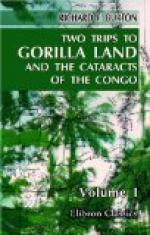I happened during the first afternoon to show my hosts a picture of the bald-headed chimpanzee, Nchigo Mbuwwe (Troglodytes calvus), here more generally called Nchigo Mpolo, “large chimpanzee,” or Nchigo Njue, “white-haired chimpanzee.” They recognized it at once; but when I turned over to the cottage ("Adventures,” &c., p. 423), with its neat parachute-like roof, all burst out laughing.
“You want to look him Nago (house)?” asked Hotaloya.
“Yes, for sure,” I replied.
Forteune set out at once, carrying my gun, Selim followed me, and the rear was brought up by a couple of little prick-eared curs with a dash of the pointer, probably from St. Helena: the people will pay as much as ten dollars for a good dog. They are never used in hunting apes, as they start the game; on this occasion they nearly ran down a small antelope.
The path led through a new clearing; a field of fern and some patches of grass breaking the forest, which, almost clear of thicket and undergrowth, was a charming place for deer. The soil, thin sand overlying humus, suggested rich crops of ground-nuts; its surface was everywhere cut by nullahs, now dry, and by brooks, running crystal streams; these, when deep, are crossed by tree-trunks, the Brazilian “pingela.” After twenty minutes or so we left the “picada” (foot-path) and struck into a thin bush, till we had walked about a mile.
“Look him house, Nchigo house!” said Hotaloya, standing under a tall tree.
I saw to my surprise two heaps of dry sticks, which a schoolboy might have taken for birds’ nests; the rude beds, boughs, torn off from the tree, not gathered, were built in forks, one ten and the other twenty feet above ground, and both were canopied by the tufted tops. Every hunter consulted upon the subject ridiculed the branchy roof tied with vines, and declared that the Nchigo’s industry is confined to a place for sitting, not for shelter; that he fashions no other dwelling; that a couple generally occupies the same or some neighbouring tree, each sitting upon its own nest; that the Nchigo is not a “hermit” nor a rare, nor even a very timid animal; that it dwells, as I saw, near villages, and that its cry, “Aoo! Aoo! Aoo!” is often heard by them in the mornings and evenings. During my subsequent wanderings in Gorilla land, I often observed tall and mushroom-shaped trees standing singly, and wearing the semblance of the umbrella roof. What most puzzles me is, that M. du Chaillu




